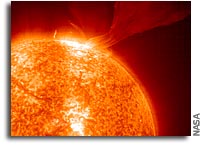Space Weather Model Picked to Improve Solar Storm Warning System

A University of Michigan space weather model beat out four other contenders for a spot in the national Space Weather Prediction Center’s forecasting toolbox. It is the first time that computer models based on a firm understanding of physics have overtaken simpler, statistics-based models to predict magnetic disturbances due to space weather. The new model can also give information about where the effects of a geomagnetic storm will be weaker or stronger around Earth.
Space weather forecasts are important for protecting satellites, predicting when GPS signals become unreliable, and in the worst case, preventing far-reaching and long-term electrical power outages.
Most of the time, Earth’s magnetic field unflinchingly deflects most of the charged particles shed by the Sun, known collectively as the solar wind. Yet every now and again, the Sun ejects a chunk of material — still charged particles but a lot more of them.
“You can have eruptions like coronal mass ejections or solar flares, and these propagate all the way from the Sun to the Earth,” said Gabor Toth, a research scientist in atmospheric, oceanic and space sciences and one of the model’s main developers. In a gale-force solar wind brought on by these eruptions, Earth’s magnetic field shakes.
The main fear is that this shaking could knock out the big transformers in the electrical grid. “These power grids always operate on the edge, and if you put an extra load on, they can fail,” said Toth.
As Earth’s magnetic field moved, it would create its own currents in the high-voltage cables that carry electricity across hundreds of miles. At substations, where transformers convert the electricity to lower voltages for delivery into cities and towns, that extra current would likely push transformers over the edge.
Since crisscrossing the Earth with high-voltage cables and sending satellites into orbit, humans haven’t experienced space weather that could cause worldwide disruption. The last event of that magnitude was in September 1859. Only the telegraph system was around to preview how Earth’s roiling magnetic field can fry long-distance electrical systems.
Because large transformers take between five months and five years to build, a modern version of that storm could mean prolonged, extensive blackouts. “It would really be a disaster much worse than a major hurricane,” said Toth.
Fortunately, crisis could be averted by reducing the voltage or switching off parts of the grid entirely. Then, magnetically induced currents would be much less likely burn out transformers. Also, powering down satellites could prevent the crippling of communications systems. To take such precautions wisely, grid and satellite operators need accurate space weather forecasting.
Direct observations of the solar flares aren’t clear enough to tell whether any extreme plasma from the Sun is heading toward us. For that, our first responder is on a small orbit around a point where the gravitational pull of the Sun and Earth are equal, roughly a million miles from Earth. This satellite, the Advanced Composition Explorer (ACE), measures the solar wind.
“When we start our model from this point, we are able to make quantitative predictions that are better than the empirical models,” said Toth.
Using measurements from ACE, the National Oceanic and Atmospheric Administration’s (NOAA) Space Weather Prediction Center has been making forecasts from statistics-based, or empirical, models for space weather. These models work reasonably well for estimating the strength of magnetic fluctuations on a global level within the range of space weather observed before. However, these models cannot predict events outside their statistical comfort zones, like the 1859 storm, or where around Earth magnetic disturbances will occur.
That’s why NOAA put out a call for new models that could provide more accurate predictions. They tested two empirical models with local forecast capabilities and three physics-based models, including Michigan’s. The physics models out-performed the empirical models and Michigan’s came out tops.
While overtaking statistical models from ACE onward was an important milestone, that only gives an hour of lead-time for the ordinary solar wind or 20 minutes for extreme space weather. It’s just enough time to switch off transformers and satellites, but the military is looking for five days’ notice. That would mean predicting major eruptions on the Sun days before they occurred.
For the next big goal, Toth would be happy to make predictions based on observations of the Sun’s surface. “That would give a lead time of one to two days,” he said. “That would be a huge step up.”
Contact:
Nicole Casal Moore
Public Relations Rep.
+1 734-647-7087
ncmoore@umich.edu
The model is called the Space Weather Modeling Framework (SWMF). The main developers are Gabor Toth, Darren De Zeeuw, Igor Sokolov and Bart van der Holst, all research scientists in atmospheric and space sciences. Professor Aaron Ridley and research scientist Daniel Welling played important roles in the model development and the U-M participation in the competition. The Center for Space Environment Modeling is led by Tamas Gombosi, the Rollin M. Gerstacker Professor of Engineering and professor of atmospheric, oceanic and space sciences and aerospace engineering.
X









